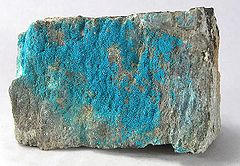Langite
| Langite | |
|---|---|

Langite from Podlipa and Reinera Mines, Slovakia
|
|
| General | |
| Category | Copper minerals |
|
Formula (repeating unit) |
Cu4(SO4)(OH)6·2H2O |
| Strunz classification | 7.DD.10 |
| Dana classification | 31.4.3.1 |
| Crystal system | Monoclinic |
| Crystal class | Domatic (m) (same H-M symbol) |
| Space group | Pc |
| Unit cell | a = 7.118, b = 6.031 c = 11.209 [Å] β = 90.00−90.02°; Z = 2 |
| Identification | |
| Formula mass | 488.32 g/mol |
| Color | Greenish blue, sky-blue to bluish green |
| Crystal habit | Crystals scaly, or as crusts; earthy |
| Twinning | Common on {110}, typically repeated |
| Cleavage | {001} perfect, {010} distinct |
| Fracture | Uneven |
| Mohs scale hardness | 2.5 to 3 |
| Luster | Vitreous, crusts silky |
| Streak | Blue green |
| Diaphaneity | Translucent |
| Specific gravity | 3.28 3.48 to 3.5 3.5 2.28 to 3.34 |
| Optical properties | Biaxial (-) r>v weak |
| Refractive index | nα = 1.708 nβ = 1.760 nγ = 1.798 |
| Birefringence | δ = 0.090 |
| Pleochroism | X = c = light yellowish green Y = b = blue-green Z = a = sky blue |
| Solubility | Insoluble in water, easily soluble in dilute acids or NH4OH |
| Other characteristics | May be altered to brochantite. Not radioactive |
| References | |
Langite is a rare hydrated copper sulfate mineral, with hydroxyl, found almost exclusively in druses of small crystals. It is formed from the oxidation of copper sulfides, and was first described in specimens from Cornwall, England. It is dimorphous with wroewolfeite. Langite was discovered in 1864 and named after the physicist and crystallographer Viktor von Lang (1838–1921), who was Professor of Physics at the University of Vienna, Austria.
Langite belongs to the monoclinic crystal class m, meaning that it has just one mirror plane, and no axes of rotational symmetry. The crystal is built up of identical unit cells stacked together, with no space in between. The unit cell for the monoclinic system has a base which is a rhombus, with sides a and c inclined at angle β. The third side b is perpendicular to both a and c. For langite the angle β is very close to 90°, so the unit cell is almost brick-shaped (as for the orthorhombic system). Different sources give slightly different values for the unit cell parameters, but they all fall within the ranges a = 7.118 Å to 7.137 Å, b = 6.031 Å to 6.034 Å, c = 11.209 Å to 11.217 Å, β = 90.00 to 90.02°, Z (the number of formula units per unit cell) = 2.
Langite usually occurs as druses of small greenish-blue crystals which may be scaly or earthy. It is translucent, with a vitreous to silky luster and a blue-green streak. It has perfect cleavage perpendicular to the c crystal axis, and distinct cleavage perpendicular to b. Twinning is common, and typically repeated to give snowflake or star shaped groupings. The mineral is soft, with hardness 2.5 to 3, a little less than that of calcite. Fracture is uneven, and specific gravity is in the range 3.28 to 3.50, a little less than that of diamond.
...
Wikipedia
